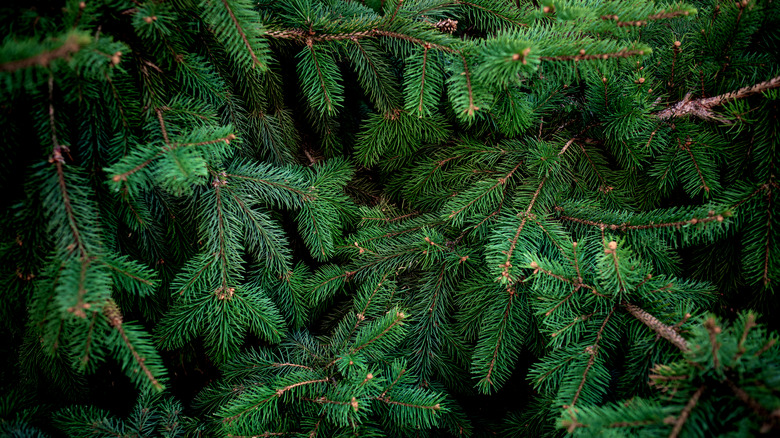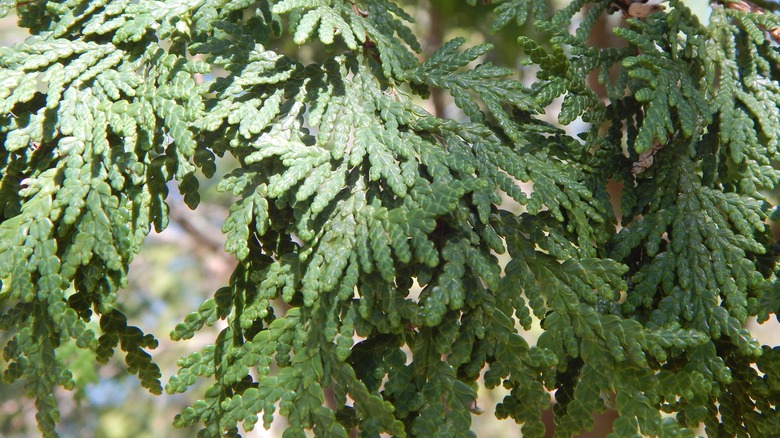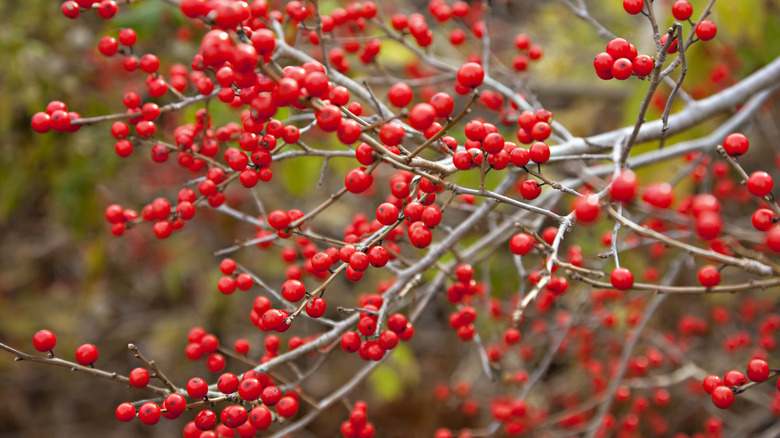The Best Cut Evergreens To Include In Your Outdoor Displays During Winter Months
There are so many evergreens to consider for your winter displays. But are some better than others? We're here to let you know which ones look best, last longer, and smell great. While some classic greenery have a "holiday vibe" based on their traditional connection to Yuletide, like holly and ivy, it turns out these can be tricky to use outdoors because of their tendency to dry out quickly. Using greens that retain their moisture, like conifers (including pine, fir, spruce, cedar, and others), is a better, low-maintenance choice for outdoor displays.
As for looks, there's a wonderful variety of textures and colors depending on which greens you can acquire. Creating a vibrant display is easy when you layer different hues and colors together: Some spruces and junipers have gorgeous blue-green tones, while some cedars (technically known as false cedars as they're actually cypress trees) range in color from blue to olive green. Yew foliage is a glossy dark emerald green. Using an array of colors to create some contrast helps create a more visually interesting display, so all the shades of green don't just blend together.
The different textures of evergreens also provide a range of possibilities: Some evergreens are shiny, some have a matte texture, some have long or short needles, while some have elaborate, brocade-like serrated leaves. Some have small cones or colorful berries to add more visual interest. Juniper, balsam, spruce, fir, and pine are particularly fragrant, but all evergreens have a fresh, bracing scent.
Choosing evergreens for color and texture
You can have as few or as many kinds of evergreens in your display as you wish, but try to have at least three different varieties to create some contrasting hues and textures. Blue spruce and Douglas fir are commonly used for Christmas trees. They have dense groupings of short needles on their branches; blue spruce has pale frosty blue needles on new growth, and Douglas fir needles are a dark hunter green. Pine needles grow in groups of two, three, or five, and often these needles are long, which can add interesting texture placed near the shorter needles of fir or spruce boughs. Fir, spruce, and pine trees also produce cones of varying sizes and shapes.
Junipers come in many forms from creeping to upright. The feathery-looking needles are usually blue-green, tend to be sharp (handle carefully!), and may produce fragrant blue berries (some juniper berries are used to make gin). Yew shrubs produce seeds in bright red "berries" instead of cones. Be aware that the stones/seeds of yew berries are toxic if ingested by people or pets. Juniper and yew branches both hold their color and freshness very well in outdoor arrangements.
Some varieties of cedar (like the Lawson cypress)commonly grown as landscape trees, produce flat, lacy green foliage with beautiful tiny cones that hang in clusters. Their foliage stays green, is soft and easy to handle, and the thin, curving branches have smooth, shiny bark with tiny bumps, lending interesting shapes.
Shapes of evergreen branches
In addition to the color, texture, and shape of the foliage, evergreen branches have different forms that can add interest to your arrangement. The "thriller, filler, spiller" formula used to create plant containers is actually well suited for using evergreens. Some pines and firs have graceful, loose, hanging branches that can be placed so they drape or "spill" over the edge of the container. Cedars can also be used this way since the branches are often slender and curving. Creeping juniper can also have curving branches that can be used to create interest in the lower portion of your container.
Some evergreens have firm branches that will stand up straight, while others might tend to droop. Knowing how these different forms behave helps you create an arrangement that will hold its shape. Yew branches tend to stay upright and so are good for adding some height or vertical interest: they can make good "thrillers." Pines with long clusters of needles like Eastern white pine tend to have soft, lightweight branches that add a delicate, airy texture when placed in the middle of your arrangement, so they're excellent for "fillers."
Consider adding other natural materials to round out your evergreen display. Using pine cones as "fillers" adds a natural look and some interesting texture. Branches of dogwood (red) or birch (white or grey) add some color, or sprays of winterberry holly with bright red berries that last for weeks (unlike other hollies that tend to dry out).


